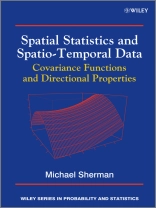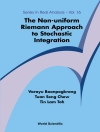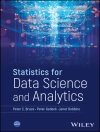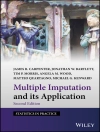In the spatial or spatio-temporal context, specifying the correct
covariance function is fundamental to obtain efficient predictions,
and to understand the underlying physical process of interest. This
book focuses on covariance and variogram functions, their role in
prediction, and appropriate choice of these functions in
applications. Both recent and more established methods are
illustrated to assess many common assumptions on these functions,
such as, isotropy, separability, symmetry, and intrinsic
correlation.
After an extensive introduction to spatial methodology, the book
details the effects of common covariance assumptions and addresses
methods to assess the appropriateness of such assumptions for
various data structures.
Key features:
* An extensive introduction to spatial methodology including a
survey of spatial covariance functions and their use in spatial
prediction (kriging) is given.
* Explores methodology for assessing the appropriateness of
assumptions on covariance functions in the spatial,
spatio-temporal, multivariate spatial, and point pattern
settings.
* Provides illustrations of all methods based on data and
simulation experiments to demonstrate all methodology and guide to
proper usage of all methods.
* Presents a brief survey of spatial and spatio-temporal models,
highlighting the Gaussian case and the binary data setting, along
with the different methodologies for estimation and model fitting
for these two data structures.
* Discusses models that allow for anisotropic and nonseparable
behaviour in covariance functions in the spatial, spatio-temporal
and multivariate settings.
* Gives an introduction to point pattern models, including
testing for randomness, and fitting regular and clustered point
patterns. The importance and assessment of isotropy of point
patterns is detailed.
Statisticians, researchers, and data analysts working with
spatial and space-time data will benefit from this book as well as
will graduate students with a background in basic statistics
following courses in engineering, quantitative ecology or
atmospheric science.
قائمة المحتويات
Preface.
1 Introduction.
1.1 Stationarity.
1.2 The Effect of Correlation in Estimation and Prediction.
1.3 Texas Tidal Data.
2 Geostatistics.
2.1 A Model for Optimal Prediction and Error Assessment.
2.2 Optimal Prediction (Kriging).
2.3 Prediction Intervals.
2.4 Universal Kriging.
2.5 The Intuition Behind Kriging.
3 Variogram and Covariance Models and Estimation.
3.1 Empirical Estimation of the Variogram or Covariance Function.
3.2 On the Necessity of Parametric Variogram and Covariance Models.
3.3 Covariance and Variogram Models.
3.4 Convolution Methods and Extensions.
3.5 Parameter Estimation for Variogram and Covariance Models.
3.6 Prediction for the Phosphorus Data.
3.7 Nonstationary Covariance Models.
4 Spatial Models and Statistical Inference.
4.1 Estimation in the Gaussian Case.
4.2 Estimation for Binary Spatial Observations.
5 Isotropy.
5.1 Geometric anisotropy.
5.2 Other Types of Anisotropy.
5.3 Covariance Modelling under Anisotropy.
5.4 Detection of Anisotropy: The Rose Plot.
5.5 Parametric Methods to Assess Isotropy.
5.6 Nonparametric Methods of Assessing Anisotropy.
5.7 Assessment of Isotropy for General Sampling Designs.
5.8 An Assessment of Isotropy for the Longleaf Pine Sizes.
6 Space-time Data.
6.1 Space-Time Observations.
6.2 Spatio-Temporal Stationarity and Spatio-Temporal Prediction.
6.3 Empirical Estimation of the Variogram, Covariance Models, and Estimation.
6.4 Spatio-Temporal Covariance Models.
6.5 Space-Time Models.
6.6 Parametric Methods of Assessing Full Symmetry and Space-Time Separability.
6.7 Nonparametric Methods of Assessing Full Symmetry and Space-Time Separability.
6.8 Nonstationary Space Time Covariance Models.
7 Spatial Point Patterns.
7.1 The Poisson Process and Spatial Randomness.
7.2 Inhibition Models.
7.3 Clustered Models.
8 Isotropy for Spatial Point Patterns.
8.1 Some Large Sample Results.
8.2 A Test for Isotropy.
8.3 Practical Issues.
8.4 Numerical Results.
8.5 An Application to Leukemia Data.
9 Multivariate Spatial and Spatio-temporal Models.
9.1 Co Kriging.
9.2 An Alternative to Co Kriging.
9.3 Multivariate Covariance Functions.
9.4 Testing and Assessing Intrinsic Correlation.
9.5 Numerical Experiments.
9.6 A Data Application to Pollutants.
9.7 Discussion.
10 Resampling for Correlated Observations.
10.1 Independent Observations.
10.2 Other Data Structures.
10.3 Model Based Bootstrap.
10.4 Model Free Resampling Methods.
10.5 Spatial Resampling.
10.6 Model Free Spatial Resampling.
10.7 Unequally Spaced Observations.
Bibliography.
Index.
عن المؤلف
Michael Sherman, Professor of Statistics, Texas A&M
University
Michael Sherman has done extensive research on re-sampling
methods for temporally or spatially dependent data and spatial
statistics. He has published various papers in JASA, Biometrics and
JRSS-B. In 2000 he created a course in Spatial Statistics at
Texas A&M University and has given over 35 invited
presentations at University seminars, ASA meetings and special
topic meetings.












